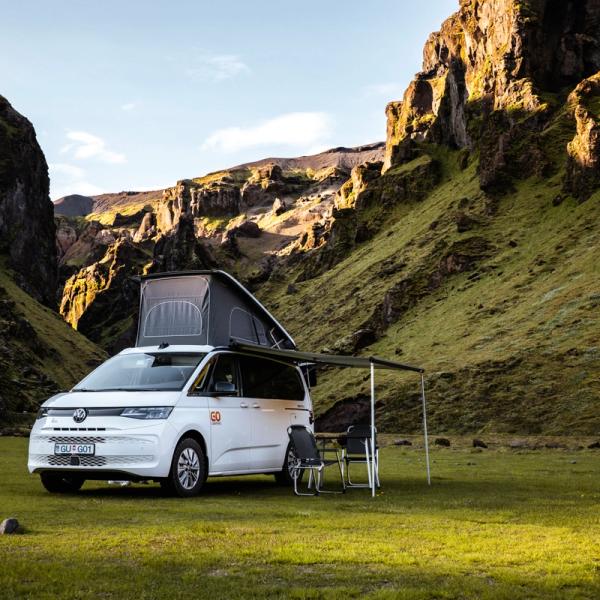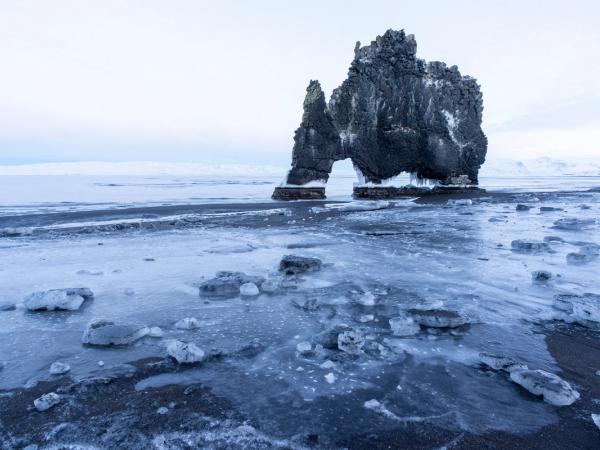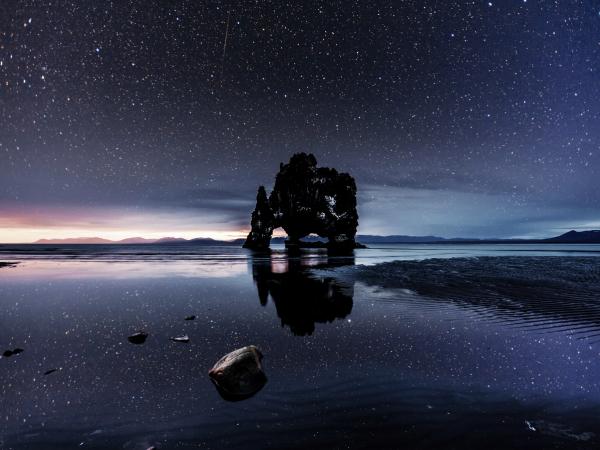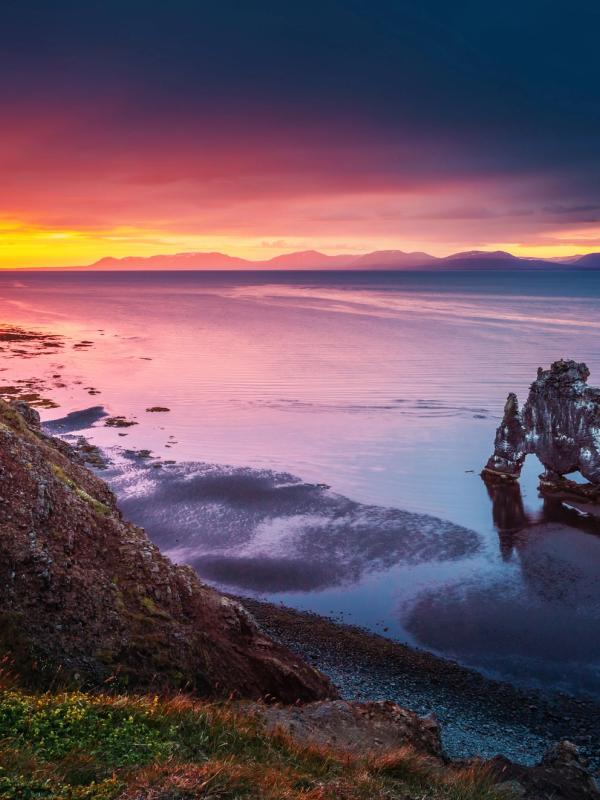
Hvítserkur in Iceland: A Troll Frozen in Time
Hvítserkur, a 15-meter rock sticking out of the sea on Iceland's Vatnsnes peninsula, looks like something from a fantasy movie. This rock stack draws visitors with its odd shape – some see a dragon drinking from the ocean, others a dinosaur, but local stories say it's actually a troll caught by the sunrise and turned to stone.
Here's everything you need to know about visiting this natural landmark in Northwest Iceland.
Key takeaways
- Hvítserkur is a 15-meter rock stack in Northwest Iceland, shaped like a drinking animal or troll.
- The formation is 12-13 million years old and has been strengthened with concrete to stop it from wearing away
- Best visited during summer (June-August) for mild weather, though each season offers different views
- Bring layered, waterproof clothing and sturdy hiking boots for the walk down to the beach.
- The area is home to seals and many seabirds.
- Access is via Route 711, a gravel road that most cars can handle in good weather
What's Hvítserkur?
Hvítserkur (pronounced "KVEET-ser-kur") is a rock that stands 15 meters tall in Húnaflói Bay on Iceland's northwestern coast. The name means "white shirt" in Icelandic, referring to the white bird poop that often covers the rock; not the prettiest name for such a striking formation!
What makes this rock special is its shape, with two holes at its base, creating the illusion of legs. Depending on your angle, it resembles a dragon drinking from the sea, a rhino, an elephant, or, according to folklore, a troll.
The rock is a nesting spot for seabirds like fulmars, gulls, and shags. If you look into the water or along the beach, you might also spot seals, making it a great place for wildlife fans.
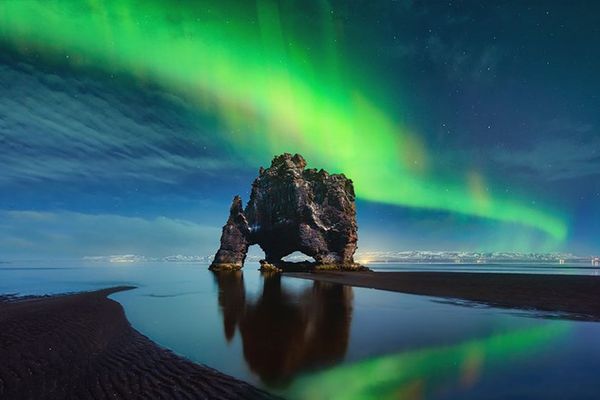
How was Hvítserkur formed?
Hvítserkur wasn't always a standalone rock in the sea. It's what scientists call a volcanic plug, basically the hardened lava from inside an old volcano's vent. This formation dates back to the Early Miocene period, about 12-13 million years ago.
Over time, the ocean waves wore away the softer rock around this hardened volcanic plug, leaving behind the striking sea stack we see today. The erosion created the leg-like shapes at its base, where waves have cut through.
In the mid-20th century, local farmers were concerned about the sea gradually eroding Hvítserkur, particularly after a major earthquake in 1963 nearby. To keep the formation from falling down, they added concrete to its base. This effort has been key to keeping this natural wonder intact: a nice example of humans helping nature for once!
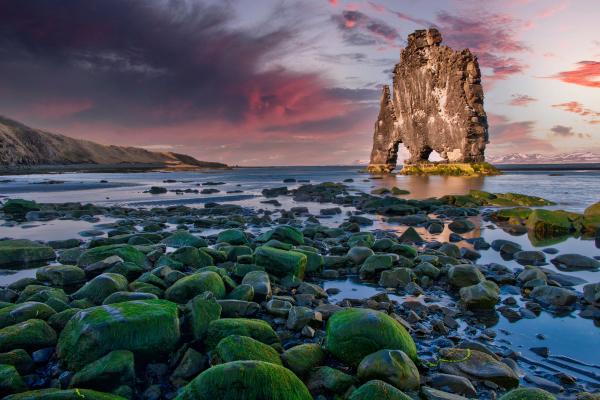
Location & How to get there
Hvítserkur is located on the eastern shore of the Vatnsnes peninsula in Northwest Iceland, sticking out of Húnaflói Bay. While it's not on the main tourist path, that's part of what makes it special.
To get there from Reykjavik, drive north on the Ring Road (Route 1) for about 3 hours until you reach the town of Blönduós. From there, follow Route 711, a gravel road that circles the Vatnsnes peninsula. Hvítserkur is about 30 minutes from Blönduós. The whole journey from Reykjavik takes about 3.5-4 hours each way, making it doable as a long day trip if you're up for it, although I wouldn’t recommend it.
From Akureyri (Iceland's "northern capital"), the journey is shorter, about 2 hours total. Take Route 1 west toward Blönduós, then follow the same directions onto Route 711.
The final approach involves parking at a lot off Route 711 and then either walking to a viewing platform above or taking a 300-meter trail down to the black sand beach for a closer look. The path down can be steep and slippery when wet, so good shoes are a must.
Keep in mind that Route 711 is a gravel road. While most regular cars can handle it in good weather, conditions can change quickly in Iceland. During winter, a 4x4 vehicle is recommended, and it's always best to check road conditions before heading out.
Things to do there
Hvítserkur and its surroundings offer plenty to keep you entertained.
Photography
Hvítserkur is perfect for photos with its bold shape against the sky and sea. The rock looks different throughout the day as lighting changes, with early morning and late afternoon offering the best conditions for dramatic shots.
For the best photos:
- Visit during the golden hour (after sunrise or before sunset) when the light is soft and creates nice shadows
- Try both the viewing platform (for height) and the beach level (for a different angle)
- Include the reflections in the wet sand during low tide
- In winter, capture the Northern Lights dancing above Hvítserkur
- In summer, use the Midnight Sun for unique lighting
The rock looks different from various angles, so walk around on the beach to find your favorite view. A tripod helps keep your camera steady, especially in Iceland's often windy conditions.
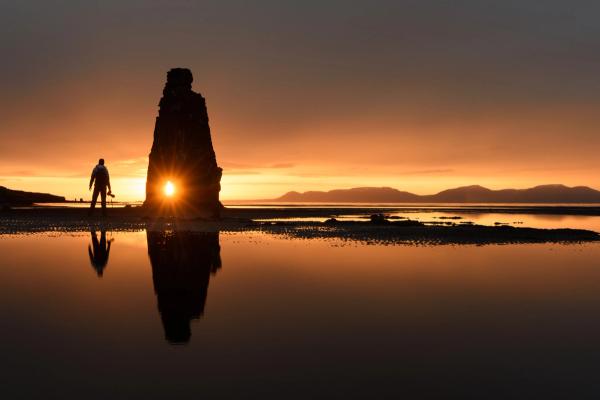
Wildlife watching
The Vatnsnes peninsula is one of Iceland's best places for seal watching, and the area around Hvítserkur is great for this. Harbor seals and gray seals often visit the waters and the shoreline.
Bring binoculars if you have them, and scan the water and nearby rocks. Early mornings tend to be the best time for seeing seals. Remember to stay at least 50 meters away to avoid bothering these wild animals.
Birdwatchers will enjoy the seabirds that use Hvítserkur as a nesting ground. Depending on the season, you might see:
- Fulmars
- Gulls
- Shags
- Arctic terns (be careful – they can be quite mean during nesting season!)
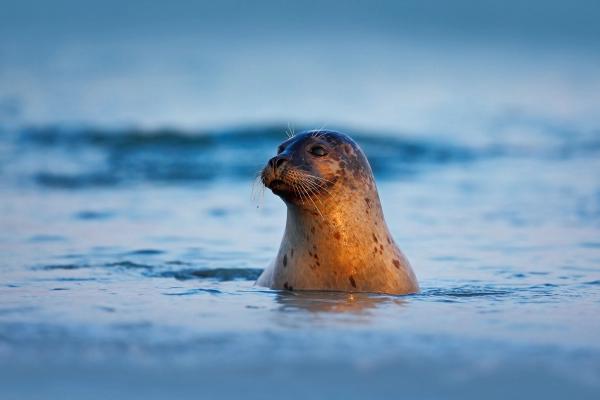
Explore the beach
The black sand beach below Hvítserkur offers a peaceful setting to simply wander and take in the rugged beauty of the Icelandic coast. The beach is small but has character, with interesting driftwood and rock formations.
Low tide gives you more space to explore and better views of Hvítserkur's full structure. Check tide times before your visit if possible.
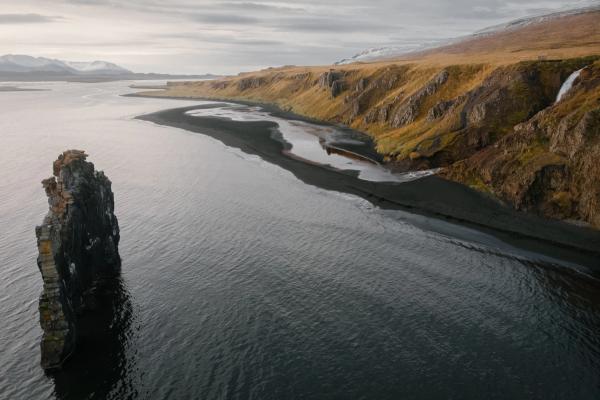
Connect with Icelandic folklore
While looking at Hvítserkur, imagine the old folktale of the troll who tried to destroy the bells of Þingeyrar monastery. According to legend, trolls hate the sound of church bells, and this troll was set on tearing down the monastery. However, trolls turn to stone if caught by sunlight, and this one stayed too long on his mission. Dawn broke, and he was forever frozen in stone, mid-task.
This story illustrates the clash between old pagan beliefs and Christianity in Iceland's history, a theme you'll see throughout the country.
Best time to visit Hvítserkur
Each season offers a different experience at Hvítserkur, so the best time depends on what you want.
Summer (June-August) brings mild weather, with temperatures typically ranging between 10-15°C (50-59°F). The long daylight hours, including the Midnight Sun around the solstice, provide you with flexibility for your visit and offer unique lighting for photos. This is also when wildlife is most active. However, summer brings more tourists, so if you want solitude, plan an early morning visit.
Fall (September-October) has fewer crowds, still-decent weather, and the start of the Northern Lights season. The changing light creates dramatic scenes, especially at sunset.
Winter (November-March) is tough but rewarding. Hvítserkur can look magical, covered in snow or with ice formations, and the Northern Lights might dance above it on clear nights. However, shorter days, icy conditions, and potential road closures mean careful planning is essential. A 4x4 vehicle is a must in winter.
Spring (April-May) marks the return of migratory birds and the gradual improvement of weather, with fewer tourists than in summer.
No matter the season, checking the weather forecast and road conditions is crucial before setting out. Iceland's weather can change rapidly, and it's always better to delay a visit than to take unnecessary risks.
What to wear
Iceland's coastal weather demands respect and preparation, regardless of the season. The wind at Hvítserkur can be fierce, making proper clothing essential.
Year-round essentials include:
- Waterproof and windproof outer layer (jacket and pants)
- Warm middle layer (fleece or wool)
- Sweat-wicking base layer (avoid cotton)
- Sturdy, waterproof hiking boots with a good grip for the path to the beach
- Hat and gloves (yes, even in summer)
- Sunglasses and sunscreen (the sun reflecting off water can be intense)
In winter, add extra warm layers, insulated boots, and, if necessary, ice cleats for icy conditions. The wind chill factor can make temperatures feel significantly colder than the reported temperature.
For photographers, fingerless gloves or thin glove liners can help you operate your camera while keeping your hands protected.
Don't forget practical items like a water bottle, snacks, and a small backpack to carry layers you might shed or add as conditions change.
Places to visit nearby
No matter how remote a place is in Iceland, there are always attractions to visit nearby.
Borgarvirki
About 25 minutes from Hvítserkur, Borgarvirki is a natural rock fortress that was used for defense in ancient times. This rock formation looks like a castle and offers expansive views of the surrounding countryside. Some basic changes by early Icelanders turned this natural feature into a strong defensive position. It's free to visit and great for photos.
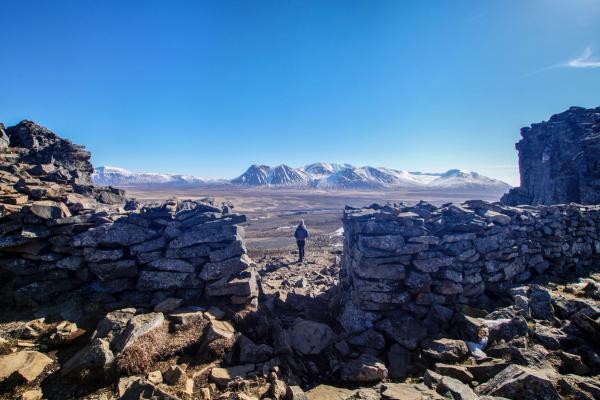
Hvammstangi
This charming town is worth a stop for its Icelandic Seal Center, where you can learn about these marine mammals through hands-on exhibits. The center also provides information on seal-watching ethics and locations. Hvammstangi has restaurants, places to stay, and gas stations, making it a good base for exploring the Vatnsnes peninsula.
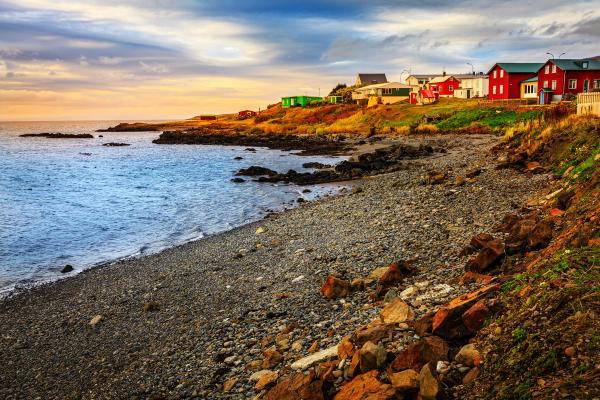
Kolugljúfur Canyon
This impressive canyon with the Kolufossar waterfalls is a hidden gem about 40 minutes from Hvítserkur. The falls cascade through the narrow gorge in a series of drops, creating a spectacular scene. There's a small parking area and viewing platform, making it an easy stop on your journey.
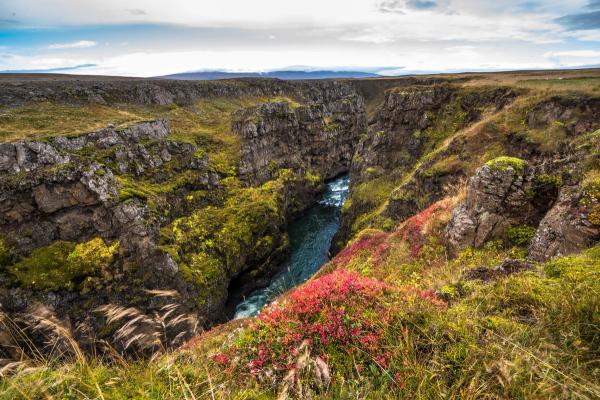
Sigríðarstaðir Beach
Known as one of the best seal-watching spots in Iceland, this beach is located on the western side of the Vatnsnes peninsula. An observation platform allows you to watch seals without disturbing them. This pairs well with the Hvítserkur experience if you're interested in wildlife.
Blönduós
This town, situated at the base of the Vatnsnes peninsula, is worth exploring for its unique church, shaped like a volcanic crater, and the Textile Museum, which showcases Iceland's rich textile history. It also offers practical amenities, such as supermarkets, restaurants, and accommodations.
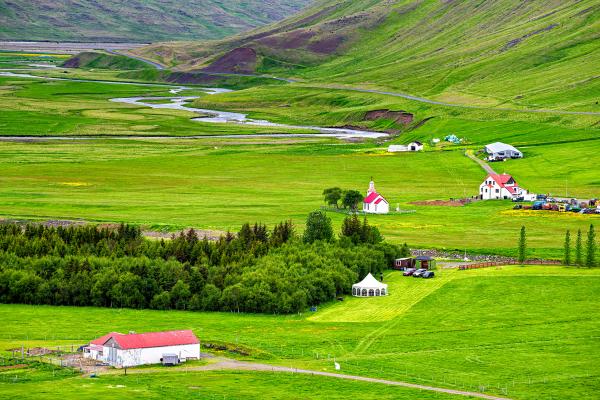
Vatnsdalshólar
These strange small hills are a geological curiosity – hundreds of them scattered across the landscape that were formed by landslides thousands of years ago. They create an unusual, almost otherworldly landscape that's interesting to photograph.
Conclusion
Hvítserkur stands as one of Iceland's most distinctive natural landmarks – a sign of the country's volcanic past and rich folklore. Whether you see it as a dragon, elephant, rhino, or frozen troll, this rock stack leaves a lasting impression with its dramatic look against the backdrop of Húnaflói Bay.

